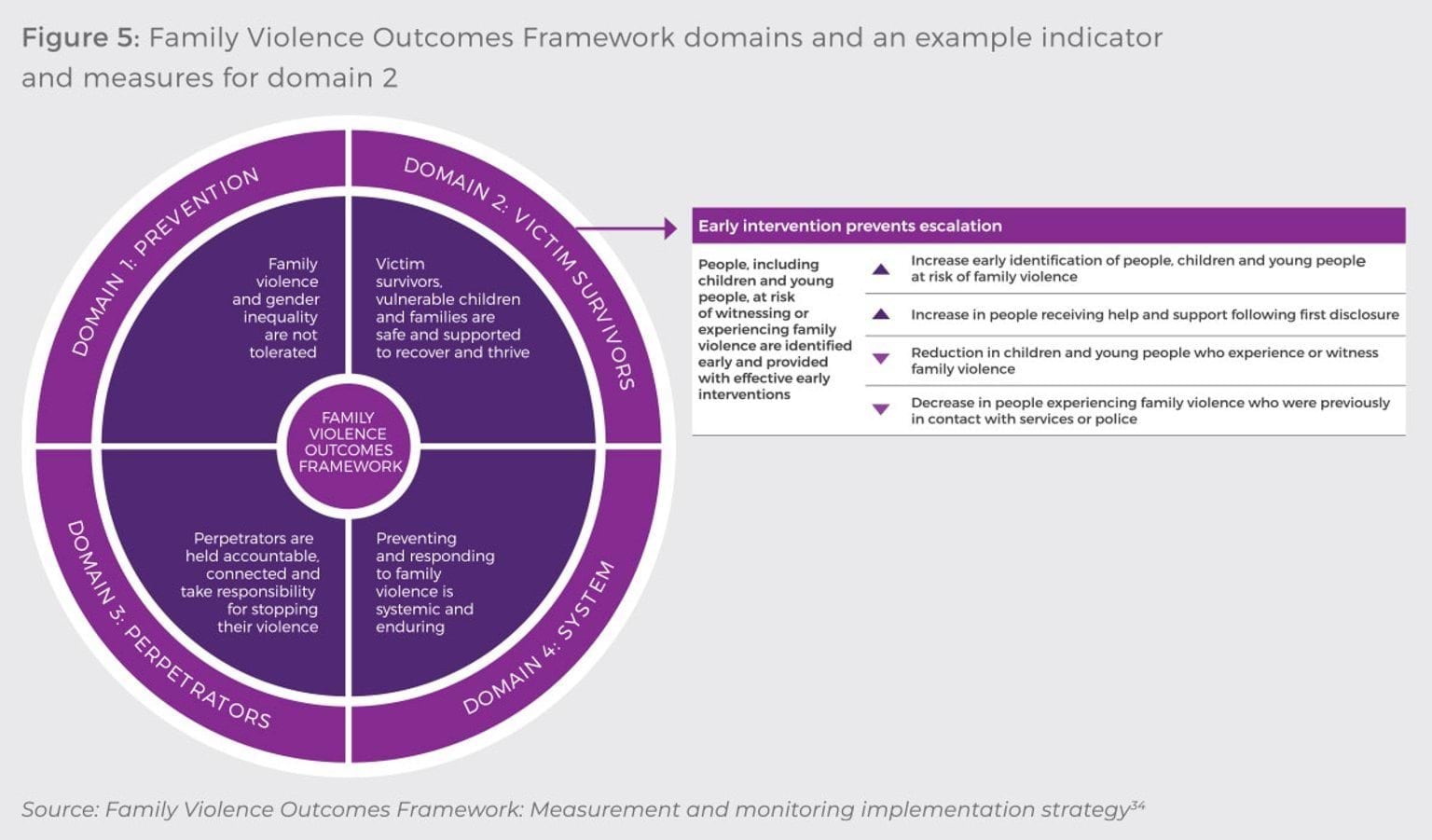The government’s 10-Year plan, Ending Family Violence: Victoria‘s Plan for Change, established a Family Violence Outcomes Framework consisting of four ‘domains’ that articulate the long-term outcomes to be achieved by the reform program34 (see Figure 5).
Government has continued to develop the framework indicators and measures and is scheduled to publish the first annual report on the measures tracking changes over time in March 2022.35 The report’s release will show progress compared with the 2016–17 baseline data (for 14 measures relating to outcome domains 1 to 3), which were published in December 2020.36 The release of the report will mark the first time there has been public visibility of progress against the family violence reform outcomes.
Across the whole reform there is a need to better articulate — and measure — how initiatives and activities contribute to the intended outcomes outlined in the Family Violence Outcomes Framework. For example, although activities in the reform’s second rolling action plan have been grouped under the broad outcomes they are expected to contribute to, the logic of the resulting short and long-term changes that lead to the overarching outcome have not been articulated. We understand that the Office for the Prevention of Family Violence and Coordination has started working with the Victorian Centre for Data Insights to strengthen the cross-government data available to measure reform outcomes. While this is a positive step, the development of measures should be informed by a theoretical framework about the changes that are expected as a result of the initiatives being implemented. The theory of change approach being taken by Respect Victoria and the Office for the Prevention of Family Violence and Coordination for the prevention domain (see Box 3) could usefully be applied across the reform to strengthen meaningful measurement of outcomes – short, medium and long-term – and assist in identifying areas of the reform where further effort is required (for example, where the expected short-term outcomes are not being seen), or where there are gaps in the reform program that need to be filled in order to achieve the intended outcomes [relates to action 11]. We also understand that Family Safety Victoria has begun a similar process for the perpetrator domain. At the halfway point of the 10-year reform program, this work should be given priority to ensure the substantial effort and investment dedicated to date is resulting in the expected change.
Box 3: Measuring change in prevention
Source: Respect Victoria
Within the whole-of-reform governance framework, accountability for achieving the reform outcomes could be strengthened. Effective governance of the reform program requires that there be clear accountability (whether individual or shared) – supported by regular and robust reporting – not just for the delivery of reform initiatives but also achievement of its outcomes. While this should occur at the whole-of-reform level (for example, through more regular and detailed reporting and oversight at the reform board level) it also requires individual departments and agencies to be responsible [refer to action 12].
Although there are a range of reporting mechanisms embedded within individual departments and agencies’ governance structures, these do not yet include monitoring of outcomes. As the broader reform outcomes monitoring work progresses, it is important that individual departments and agencies have a sophisticated understanding of progress in their areas of responsibility, including across a range of short-term outcomes linked to the achievement of the reform’s four long-term outcomes [refer to action 14]. Outside of the work undertaken on the prevention outcome domain by Respect Victoria and the Office for the Prevention of Family Violence and Coordination, and the recently commenced work on the perpetrator domain, we are not aware of any more detailed development that has been undertaken internally as part of departments’ and agencies’ oversight of their reform implementation responsibilities.37
Dhelk Dja Koori Caucus members also identified the need for significant investment in data sovereignty to gain real evidence and have ownership over the measurement of outcomes for Victoria’s Aboriginal community. The Dhelk Dja: Safe Our Way – Strong Culture, Strong Peoples, Strong Families – 3-Year Action Plan 2019–2022 outlines a commitment to Aboriginal community needs driving the collection, ownership and application of data, strengthening capacity for monitoring and evaluation within Aboriginal organisations, and adopting Aboriginal measures of success in evaluating the Dhelk Dja agreement. The issue of data sovereignty will be further examined in our forthcoming Aboriginal-led prevention and early intervention report.
Box 4: Family Violence Data Platform
The Family Violence Data Platform has been developed by Respect Victoria in partnership with the Victorian Crime Statistics Agency in response to recommendation 143 of the Royal Commission, to help the Victorian Government and its partners monitor the state’s progress in achieving its goal of preventing family violence and violence against women. This platform was built to:
- enable monitoring of long-term, population-level progress towards the primary prevention of family violence and violence against women in Victoria
- improve targeting of programs through measurement and analysis of the underlying drivers of violence
- guide and support strategic primary prevention prioritisation, policy, program design and investment in Victoria
- drive the consolidation, expansion and uptake of the quantitative evidence base by making Victorian‑level data publicly available in one place and identifying key data gaps and opportunities for future investment in data collection.
Source: Respect Victoria
Endnotes
34 State of Victoria (2021): Family Violence Outcomes Framework: Measurement and Monitoring Implementation Strategy. Available at vic.gov.au/sites/default/files/2021-01/Family-Violence-Outcomes-Framework-Implementation-Strategy_0.Pdf (accessed 10 December 2021).
35 The report was originally scheduled for publication in December 2021.
36 State of Victoria (2021): Family Violence Outcomes Framework: Measurement and Monitoring Implementation Strategy. Appendix 1: baseline report. Available at vic.gov.au/sites/default/files/2021-01/Family-Violence-Outcomes-Framework-Implementation-Strategy_0.pdf (accessed 10 December 2021).
37 We note that Family Safety Victoria’s recently released three-year strategic plan (2021–2024) was informed by a theory of change and includes a commitment to outcomes monitoring and reporting.
Updated


